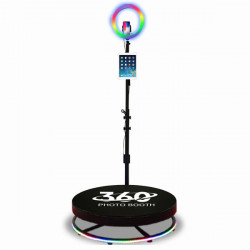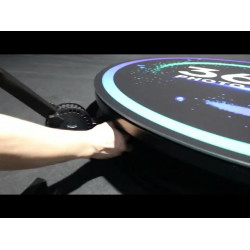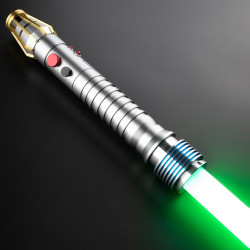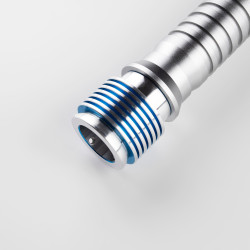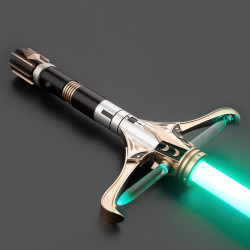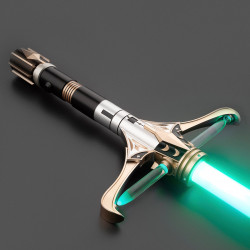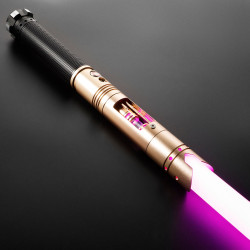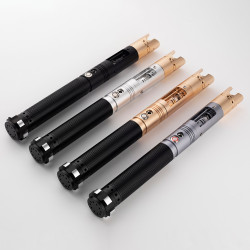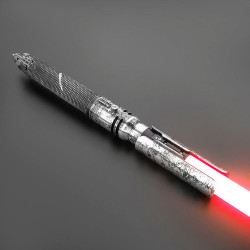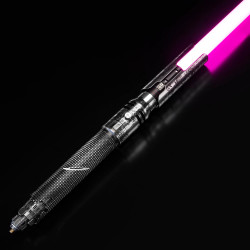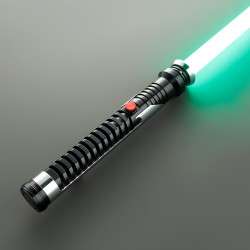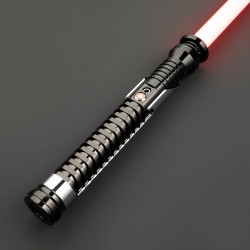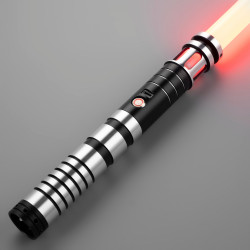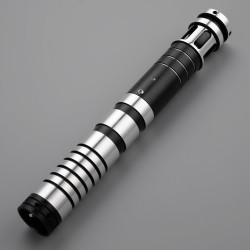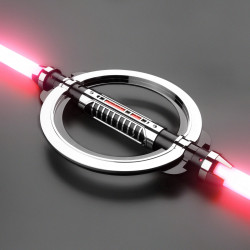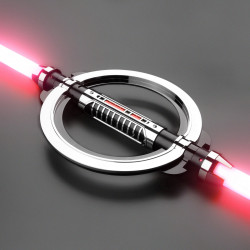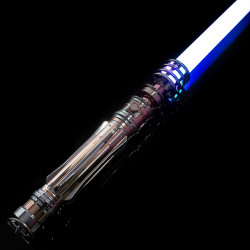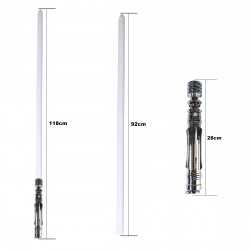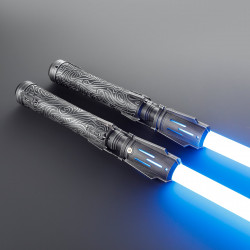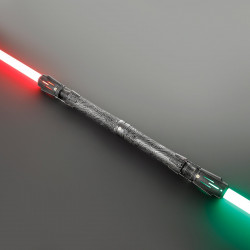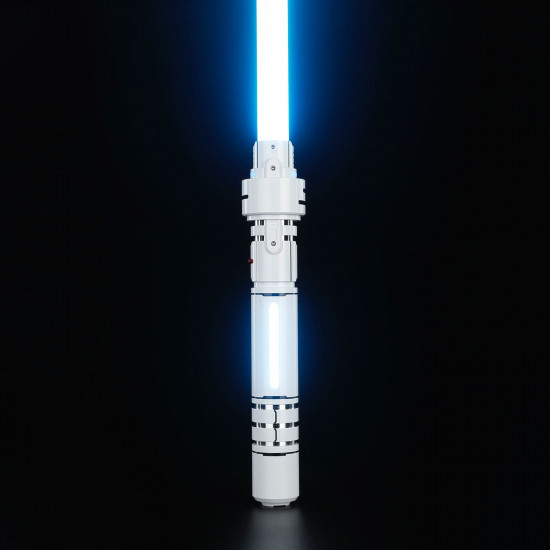
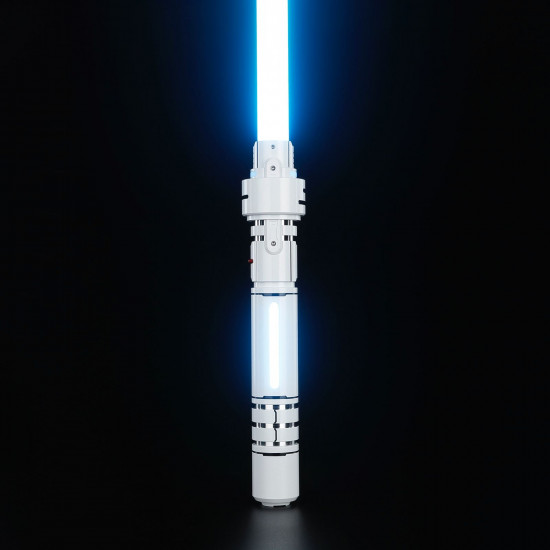
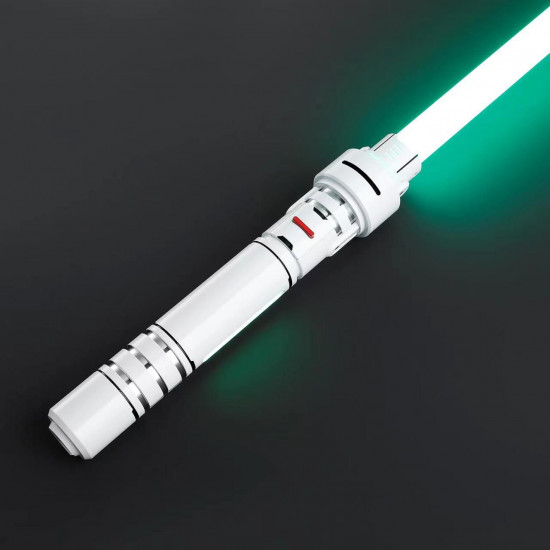
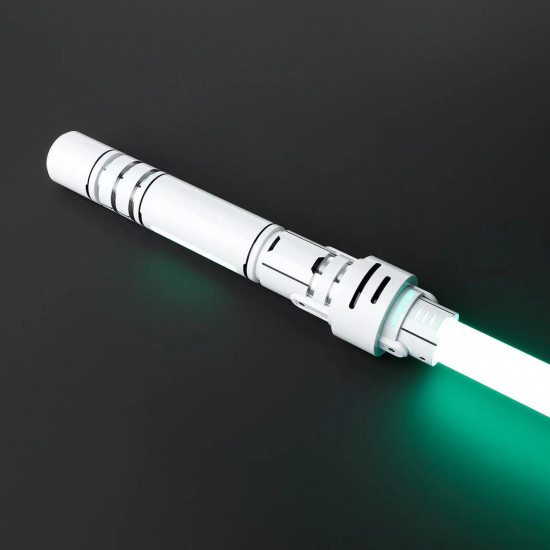
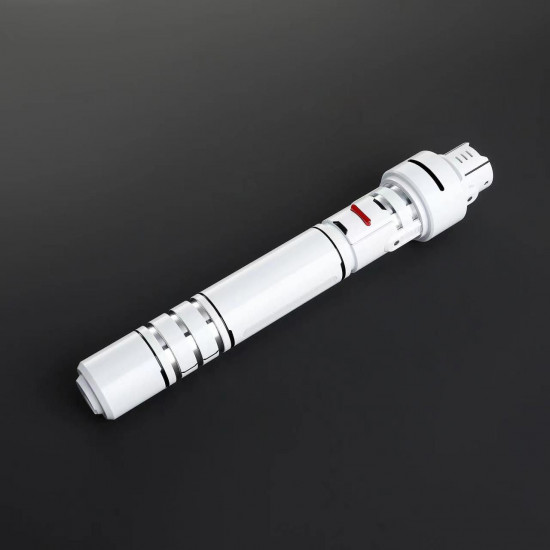





You will receive an email containing the order number and logistics information
US and Europe: 10-15 days
Other Regions: 15-20 days
Expedited can be sent to DHL, 3-7 days to arrive, the freight needs to be paid by yourself. Please contact us if necessary
TRACKING
1.Once the order is shipped, please allow 1-3 business days for the tracking number to be fully updated on the post office system. Please note that your order is actually on the way and there is no delay of the package rather than the tracking number status.
2.If you encounter any problems, please contact me via email.
Inspired by the beam saber from the Japanese science fiction franchise Gundam
Only charge with a 5v 1 amp max charger
Proffie and Xenopixel version has LEDs in the grip that mirror the blade. Baselit version does not have a lit grip
Default blade length 36"
Other blade options are 32" and 28"
Blade Diameter 1"
USB - C charging
Includes charger, screws and hex key
Take Control of Your Inner Strength with the Gundam Beam Lightsaber!
Compared to others, this masterpiece is more reasonably priced and has all the functionality you could possibly need. Neopixel and baselit lightsabers are the options available to you. An excellent option for novices or those wishing to expand their collection with a new custom fx lightsaber at a reasonable cost!
We provide our sabers with a PC (Baselit V3) or Neopixel (Xeno3 Neopixel) blade.
We designed our Baselit V3 Sabers to be used in Heavy Duelling.We designed our Xenopixel V3 Sabers for Easy to Medium Levels of Duelling.
Harness Your Power Within with the Gundam Beam Lightsaber!
- Stock: In Stock
- Model: combat-saber-model-gundam-beam
- SKU: combat-saber-model-gundam-beam
Available Options
SABER CONFIGURATIONS
This is a summary of the setups we provide. For further information, see the box above under "Which version to choose?"
- Standard : the basic model, which now has a Xeno 3 board and offers excellent audio, many effects, and customization via an SD card or smartphone app. Baselit sabers, designed for heavy battling, have a lighter blade than standard sabers. It's ideal if you want to participate in stunt/duel accomplishments or cosplay or don't require the Neopixel Blade.
- Premium : It's the choice we desire the most! A Neopixel blade on the same brand-new Xeno 3 board. The blade's high-density LED strip provides an incredible appearance and many visual effects. Currently modifiable via an SD card and, as always, a mobile app.
- Deluxe: For the programmers among you, the Proffie v2.2 board offers fully programmable styles and effects with only one function button. This is the best neopixel lightsaber available. You will adore this if you like getting your hands filthy (mainly with your keyboard) and customizing objects around you!
MAIN FUNCTIONALITIES
All of our sabers provide the following :
- Detachable polycarbonate cutting edge
- You can choose any color for your blade with the complete RGB color picker or fast access presets.
- Control the volume from 0% to 100%.
- Smooth swing: Your lightsaber's humming sound responds precisely to every move you make and is very motion-sensitive.
- Numerous sound fonts and blade styles are pre-loaded, with the option to add and modify your own (Xeno3 sounds and colors, complete control over Proffie).
- Hilts are made of 6063 aluminum and are CE-approved for XENO3 ONLY. They also include free mobile app control and Bluetooth capabilities. Because of the thickness of the hilt, certain sabers have a poor connection; the manufacturing description has further information.
BLADE SPECS
- Baselit sabers are powered by a 12W LED module housed in the handle. Blades are designed for heavy dueling and have a diameter of 1 inch and a thickness of 2 mm.
- Neopixel blades with a full-length, high-density LED strip within are found in Premium and Deluxe sabers. See their description for additional details. Polycarbonate, either 1 inch in diameter and 3 mm thick or 7/8 inch in diameter and 2 mm thick. Although we do not recommend using the 3mm thickness for intensive dueling because of the possibility of damaging the internal LED circuit, it is possible to battle with them. Buying more blades with varying lengths, thicknesses, and widths is possible.
- You may use the tip drag effect and smooth ignitions with the neopixel blades. The neopixel blades included in Premium and Deluxe sabers also significantly improve blaster effects, flash-on-clash, and saber lockups.
BATTERY AND BOARDS
- Rechargeable 3000mAh and 3600mAh batteries can run a saber for one to three hours, depending on whether it's a profile, neopixel, or basalt saber and the effects you're utilizing.
- Never charge a USB device on a computer, console, dongle, hub, or rapid charger—always use a 1A 5V USB charger. Your board will be damaged by improper power outputs and charging devices; the warranty will not cover this.
- Every saber comes with a recharge cable. To charge the Battery, place it either directly on the core (slide the core out or remove the grip part) or behind the pommel piece if the port is visible.
What's in the box ?
✅ The hilt
✅ The blade
✅ Battery
✅ Charging solution (cable or charger)
✅ Tools set
✅ Instructions manual
Xeno3 Baselit Features
For those who want to duel with their lightsabers or are searching for less expensive solutions, Xeno3 Baselit is a fantastic choice. With a variety of colors, effects, motion control, and app support, Xeno3 Baselit is a fully functional core.
Although baselit sabers are not as brilliant as the Xeno3 Neopixe option, they are more suited for spinning or battling, and the replacement blades are less expensive.
We advise selecting a Xeno3 Neopixe or Proffie if you want more realism, stronger light, and sophisticated effects like tip drag.
Check the details below.
12 Blade colors
At the touch of a button, 12 distinct blade colors—Red, Blue, Yellow, Cyan, Ice Blue, Green, Pink, Orange, Purple, Pink-Green, Rose, and White—can be changed.
Xeno Configurator
Control lightsaber features via iPhone or Android app.
34 Preinstalled Soundfonts
Saber sound board has 34 different soundfonts (aka sound profiles) and blade lighting effects that go along.
Whispers of Power, The Teacher, The Second, The Learner, The Dark Lord Revisited, The Champion, Serenity, Idyll, Hatred, Dark Ages, Cyber Terror, Codex of Light, Luke Skywalker, Scavenger Rey, Ray Skywalker, Master Yoda, Ascension Gun, Starlight, Revan, LOR SAN TEKKA, Cal Kestis, Darth Vadar, Darkness, ObiWan Kenobi, Count Dooku, The Emperor, Kylo Ren, Mark Pontillas, Darth Maul, Obiwan Kenobi, The Dark Sword, Scavenger Rey, Kylo Ren, Sailor Moon
Smoothswing
Saber makes realistic lightsaber noises in response to motion. The latest soundboard provides precise and controlled saber movement sounds.
Duel ready
Tough and durable Polycarbonate blade is able to withstand heavy dueling against other sabers.
Flash-on-clash
When two saber blades hit each other or other objects they produce a characteristic lightsaber flash.
Motion ignition
Twist the saber hilt to ignite or retract the saber.
Rechargeable battery
AAA batteries no longer need to be changed frequently thanks to a powerful rechargeable battery and an integrated recharging connector. There is a battery charger available.
Extended battery
While most batteries utilize a 1200mAh battery, this saber contains a more powerful 3000mAh rechargeable battery.
Xeno3 Neopixe Features
If you want the most features and realism, Xeno3 Neopixe is a fantastic option. With their 50W ultra-bright LED strip blades and effects, Xeno3 Neopixe sabers are a unique experience for any enthusiast.
To match the hilt workmanship with the best characteristics and realism of Xeno3 Neopixe, we suggest using Xeno3 Neopixe cores on our master sabers.
Check the details below.
Customization
The Xeno3 Neopixe board offers the full customization of and ability to add new soundfonts, blade lighting effects, blade colors, motion effects, and much more.
SD Card
16 GB SD card to enable customization.
Xeno Configurator
Control lightsaber features via iPhone or Android app.
34 Preinstalled Soundfonts
Saber sound board has 34 different soundfonts (aka sound profiles) and blade lighting effects that go along.
Included Soundfonts:
Whispers of Power, The Teacher, The Second, The Learner, The Dark Lord Revisited, The Champion, Serenity, Idyll, Hatred, Dark Ages, Cyber Terror, Codex of Light, Luke Skywalker, Scavenger Rey, Ray Skywalker, Master Yoda, Ascension Gun, Starlight, Revan, LOR SAN TEKKA, Cal Kestis, Darth Vadar, Darkness, ObiWan Kenobi, Count Dooku, The Emperor, Kylo Ren, Mark Pontillas, Darth Maul, Obiwan Kenobi, The Dark Sword, Scavenger Rey, Kylo Ren, Sailor Moon
Infinite Colors
Supports any color on the RGB spectrum. Color settings can be controlled via an app.

Blade lighting effects
Color Change, Blaster Deflection, Saber Lock-up effect, Flash-On-Clash, Stab, Rainbow, Blade Spin, neutral light, stable and unstable colors, Motion activated Saber Ignition.
Sound Effects
Along with blaster deflection, saber lock-up, stab effect, tip melt effect, and other features, the Neopixel board comes with pre-installed sound effects.
Smoothswing
In reaction to motion, Saber emits lifelike lightsaber sounds. The most recent soundboard produces regulated and accurate sounds of saber movement.
Flash-on-clash
When two saber blades hit each other or other objects they produce a characteristic lightsaber flash.
Rechargeable battery
A strong rechargeable battery and an integrated recharge connector eliminate the need for frequent AAA battery replacements. A battery charger is included.
Extended battery
While most sabers utilize a 2000mAh battery, this saber contains a more powerful 3600mAh rechargeable battery.
Advanced audio
Powered by High-Quality Speakers with a 2/3 Watt & 4/8 ohm system
Blade
Made our of durable polycarbonate. Inside an Extremely Bright 50-Watt pixel LED Strip.
Protection systems
Battery overcharge protection, system overload protection, battery installing protection.
Proffie 2.2 Features
For those seeking the maximum level of realism and features, Proffie is an excellent option. The core with the greatest degree of customization is this one. Nevertheless, it necessitates proficient user skills, and we suggest Xeno3 Neopixe for the majority of clients who are not seeking to upgrade their typefaces. The 50W super bright LED strip blades and effects on both the Proffie and Xeno3 Neopixesabers make using them an unforgettable experience for any fan.
We recommend Proffie or Xeno3 Neopixecores on our master sabers to match the hilt craftsmanship with the best features and realism.
Check the details below.
Customization
The Proffie 2.2 board offers the full customization of and ability to add new soundfonts, blade lighting effects, blade colors, motion effects (advanced users only), and much more.
12 Pre-Installed Blade colors
12 different blade colors changeable at the press of a button (Red, Green, Blue, Purple, Orange, Yellow, Pink and their shades in between). You can install as many custom colors as you like.
22 Pre-installed Soundfonts6
22 distinct soundfonts and blade lighting effects, including saber lock-up, saber collision and ignition, blaster deflection, motion noises, movie character quotations, and well-known music, are available on the Saber sound board. Blade lighting effects and your own soundfonts are optional.
Blade lighting effects
Color Change, Blaster Deflection, Saber Lock-up effect, Flash-On-Clash, Stab, Tip Melt, Rainbow, Blade Spin, neutral light, stable and unstable colors.
Sound Effects
The Neopixel board offers pre-installed sound effects that go along with blaster deflection, saber lock-up, stab effect, tip melt effect, and more.
Smoothswing
Saber makes realistic lightsaber noises in response to motion. The latest soundboard provides precise and controlled saber movement sounds.
Flash-on-clash
When two saber blades hit each other or other objects they produce a characteristic lightsaber flash.
Rechargeable Battery
The necessity to regularly replace AAA batteries is eliminated by a strong rechargeable battery with an integrated recharging connector. There is a battery charger included.
Extended Battery
While most sabers utilize a 1200mAh battery, this saber contains a more powerful 3600mAh rechargeable battery.
Advanced Audio
Powered by High-Quality Speakers with a 2/3 Watt & 4/8 ohm system
Blade
Made our of durable polycarbonate. Inside an Extremely Bright 50-Watt NeoPixel LED Strip.
Motion Effects
For advanced users only. Motion effects can be set up through a guide on the Proffie Forum.
All 7 Lightsaber Combat Forms Explained (& Who Used Which)
Throughout the Star Wars Saga, we witness Jedi and Sith lords employing distinct battle techniques. Some prioritize quickness and accuracy, some have an impregnable defense, while some are highly attacking. These fighting techniques are derived from several lightsaber combat forms that developed over the ages to resist the looming threat of Dark Jedi's and rising Sith lords.
The Star Wars Saga taught us that there are seven different types of lightsaber battle. The methods and strategies used by each kind vary from one another. Learning one type of lightsaber fighting can take years. Every Jedi or Sith was seen using at least one lightsaber combat form throughout the series, except for a few who learned multiple forms.
Let's discuss the various types of lightsabers, their advantages, drawbacks, and users.
Form I: Shii-Cho
Form I, sometimes referred to as the Sarlacc way or the determination form, is the original lightsaber combat form. A Sarlacc is a Tattoine creature that waits for its meal while hiding in the ground. The same beast from which Boba Fett emerged in the television series "The Book of Boba Fett." This beast was given the name "Way of the Sarlacc" because of its tenacity.
Following the Sith Lords, the Jedi council initially established Shii-Cho, and the number of Dark Jedis increased. The discovery of lightsabers, which replaced the antiquated metal swords, gave rise to the Shii-Cho form.
Unlike metal swords, which can only cut in one direction, lightsabers can now cut from all angles thanks to this innovative design. Shii-Cho was limited to simple offensive and defensive maneuvers. The Shii-Cho Form only offers simple strikes and blocks of another lightsaber, just like the archaic metal swords.
Form Given that it could effortlessly cut any melee weapons, such as clubs, swords, and the like, I was a success. Shii-Cho's development enabled Jedis to eliminate several adversaries. Shii-Cho was created with the sole purpose of disarming and destroying the opponents' weaponry, not killing them.
Limitations
Initially, Shii-Cho's innovation worked incredibly well. It made it easier for the Jedi to overcome the adversaries and maintain the Sith's dominance. Although it was fantastic, things weren't supposed to remain this way long.
Over time, the Sith lords learned the Shii-Cho Form and began to adjust to the lightsabers. Jedi battles had become more complex. Jedis was now more concerned with surviving the struggle than with disarming the adversary. The second Form of fighting was created as a result of these circumstances. More sophisticated, this design was appropriate for head-to-head lightsaber battles.
Who Used Shii-Cho?
Shii-Cho was only able to receive beginner training when the other combat forms were developed, and Jedi were involved in those more complex forms. similar to "Phantom Menace."Master Yoda was teaching the younglings Shii-Cho standard Form.
A proficient master of Form I Form engages in a head-to-head battle with any other combat Form practitioner despite the fact that it is simpler and more fundamental than other fighting forms.
Kit Fisto is a good illustration. During the Clone Wars, Kit Fisto was a form I skilled Jedi. He nearly used Form I l Form saber fighting to beat General Grievous. In addition to Fisto, noteworthy figures who have used Form I l Form saber combat include Obi-Wan Kenobi and Meera Sutrik.
Shii-Cho was indeed less skilled and less frequently utilized in lightsaber duels, although Jedi often employ it in unwinnable battles. They were informed that Shii-Cho would work if nothing else worked. Despite having to rely on the fundamentals of lightsaber combat forms, the determination form requires one to remain resolute.
Form II: Makashi
Makashi, sometimes referred to as the manner of Ysalamiri and the conflict form, is the second type of lightsaber fighting. The lizard-like Ysalamiri could defend against Force strikes by forming a defensive Force bubble. The Jedi order called Form II "the Way of Ysalamiri" in honor of Ysalamiri's tenacity.
In reaction to the Shu-Chii Form's ineffectiveness in lightsaber duels, Makashi was created. More than any other form, Makashi concentrates on lightsaber vs. lightsaber duels.
It is a graceful style of fighting that takes a great deal of practice to become proficient at. Makashi Form is all on accuracy and precision strikes on unprepared opponents and disarming them, in contrast to the Shu-Chii, which is more akin to wild lightsaber blows.
Makashi is a technical style that calls for flawless footwork and quick reflexes. With this Form, I learned how to escape lightsaber attacks easily.
The primary goal of this Form was to spend the least amount of energy possible to evade Shii-Chu users' awkward attacks. A Shu-Chii user exhausts himself against a Makashi user who blocks every strike with basic footwork since Shu-Chii is all about random attacks.
Limitations
Makashi did, in fact, excel at close-quarters lightsaber battle and remained valuable for a considerable amount of time until the new dangers began to reappear. Sith lords would soon have access to technology weaponry that could be used at greater ranges.
This time, adversaries showed up with deadly ranged weaponry, such as the droids, and projectile weapons like blaster rifles. Makashi was not sufficiently developed for long-range assaults, but he was effective in close combat, particularly when facing another lightsaber.
The Makashi kind of lightsaber proven to be inadequate and unreliable when Galaxy technology advanced dramatically. Jedi fumbled with their lightsabers to block blaster rounds. Makashi was not the Jedi's preferred Form; an Form is necessity led to the creation of the third lightsaber form. Like Shii-Chu, Makashi was exclusively accessible to a select group of students.
Who Used Makashi
Count Dooku, sometimes referred to as Darth Tyrannous, is a well-known user of the Form II Lightsaber, Makashi. The separatist army, which began as a Jedi separatist, was led by him. It was later discovered that he became an apprentice to Darth Sidious and had an evil side.
Count Dooku used a single conventional lightsaber and was a very proficient Makashi Form user. He disarmed his opponents with little effort, as we saw. In the Clone Wars, he handily defeated Assajj Ventress and the Night Sisters. Count Dooku appeared to be in control of everything, even when facing off against Obi-Wan and Anakin Skywalker, without sacrificing the accuracy of his strike.
The Makashi form was also acquired and mastered by Qui-Gon Jin, Count Dooku's Padawan: Cin Drilling, a Jedi Master, similarly masters Makashi.
Makashi is still regarded as one of the most excellent lightsaber combat forms and is very successful against Sith lords, even though it is limited against ranged attacks. This Form can defeat a mighty Sith lord, but it might not protect you against a blaster.
Combat Form III: Soresu
Soresu, sometimes referred to as the resilience form, is the third lightsaber combat form. In honor of the creature My-nocks, it is also known as "The way of the My-nock." The Jedi council developed Soresu to evade the ranged attacks. Even blaster bullets cannot penetrate the defenses of a true Soresu master. Its goal was to use a lightsaber to make a defensive shield that could stop all projectile attacks.
Form II Makashi is the ancestor of Soresu, which depends on its accuracy and agility. Soresu is constantly employed as a defense, in contrast to Makashi. Soresu improves the user's reflexes and awareness of his environment. Originally thought to be a form that would enable you to combat blaster attacks while wielding a lightsaber, Soresu has developed to the point where it can even deflect bullets.
Soresu, the third type of lightsaber fighting, only permits the use of a lightsaber to maximize defense; it does not permit wild strikes or even precise slashes. A person who uses Soresu trains his reflexes and himself more than the typical person. Before the bullet is fired, a Soresu master Jedi is supposed to assume the blaster deflecting position. Because of his quick reactions and agility, a Soresu user is reported to be able to defeat up to 20 opponents by himself.
In order to deflect any bullet coming from any direction, Soresu users maintain the blade close to their body. They keep their body in such a way as to minimize the exposure of their body to any ranged blaster.
Limitation
Even while the Soresu forms shielded you from a variety of ranged attacks, they weren't unbeatable. The goal of the Makashi form is to counter lightsaber attacks and create an offensive gap. But the Soresu form is finished and solely focused on defense. "Offense is the best defense," as the saying goes. Although Soresu could deflect bullets, he was powerless to stop the lightsaber's assault maneuvers.
Other lightsaber forms were created in order to fix all of Soresu's flaws as a result of this constraint.
Who uses Soresu
Soresu is a shape that has no offensive potential but permits maximum defense. To survive the blasters on a technologically advanced planet, you also need to master Soresu.
Every Jedi learns Soresu by fusing various lightsaber fighting techniques. We have seen countless films and television shows since the first one was broadcast in the 1970s. It shows all of the Jedi and Sith avoiding the shots with ease.
Well-known figures who are proficient in the Soresu form are Grand Master Yoda and Obi-Wan Kenobis. They might have been able to survive Order 66 when others failed because of this as well. The others were unable to deflect the bullets from behind him, but he did.
Combat Form IV: Ataru
The fourth lightsaber combat form, or aggression form, is called ataru. It was also dubbed "the way of the Hawk-bat" in reference to that animal's violent hunting style.
Unlike Form I, the Jedi had mastered lightsaber combat forms by the time Form IV was created. Initially, the fight involved slurry strikes and sporadic slashes because the Form I Form lightsaber combat had not sufficiently developed. Additionally, Jedi had not yet been adequately trained in the ways of the Force.
One of the seven advanced lightsaber combat styles, Ataru, requires a blend of Force and lightsaber capabilities. To acquire Ataru form, Jedi's have to undergo training in the ways of the Force. Only after mastering the fundamentals of earlier lightsaber fighting styles could they become proficient in Ataru.
Ataru is an offensive form that permits continuous lightsaber attacks until he finds a gap, as the name "aggression form" indicates. With a barrage of lightsaber slashes, an Ataru practitioner should be able to overwhelm his opponent and win in a matter of seconds.
Ataru's strikes, in contrast to Shii-Cho's, are constant and accurate while preventing the opponent from seeing an opportunity. An Ataru practitioner can strike the opponent from unexpected angles while maintaining defense by combining their Force talents.
To effectively master Ataru, a combination of Form III is also necessary. Ataru permitted the Jedi's to advance on the adversaries while thwarting projectile attacks such as blaster shots, whereas Soresu permitted the defensive. For a long time, the Jedi were able to win by combining offensive and defensive tactics with the ability to approach the opponent quickly.
Limitations
In fact, of all the earlier forms of lightsaber fighting, Ataru, the Form IV, was the most sophisticated. It worked incredibly well against both the ranged attacks and the Smiths. However, it had drawbacks of its own.
It took a great deal of training to learn how to attack the opponent quickly and continuously while completely deflecting incoming attacks. But even with its Force powers, Ataru was limited before its shortcomings were revealed.
Even though Ataru's offensive was unrivaled, it was hard to maintain the same defense against constant lightsaber strikes. The Jedi may dominate battles, but only for a while before blaster rounds defeat them. The Jedi council began perceiving new Forms that led to other forms since they could not risk the Jedi's fighting in the thick of the conflicts with Ataru.
Who uses Ataru?
Until the fall of the Jedi order, many Jedis and Sith lords trained Ataru, the fourth Form of Form t-saber dueling. Qui-Gon Jin and his apprentice Obi-Wan employed Ataru form against Darth Maul, as demonstrated in the film "Phantom Menace."
With relentless lightsaber attacks and a furious charge forward, Obi-Wan vanquished Maul. He ultimately threw Maul out of the ship after severing his dual-phase lightsaber in two.
Many famous Jedis and Sith lords use Ataru, one of the most sophisticated lightsabers, despite his limitations.
Form V: Shien & Djem
The lightsaber combat form's fifth Form is Formed by Shien & Djem. It is sometimes referred to as the perseverance form. "The way of Krayt Dragon" was another name for it. To solve the offense problem of its previous Form, SoForm, Form IV was created. Form IV offered the offense, but it was unable to maintain the same defense.
Form V: Shien and Djem is the outcome of yet another attempt to address this Soresu form issue. Ataru was created from the ground up in order to address the Soresu problem. But Shien and Djem So was modified in defense and was derived from Soresu (Form III).
Shien and Djem are the two halves of Form V. Djem So concentrates on the offense, while Shien keeps the defense as formidable as Soresu. The Jedi used Shien to deflect the blasters and became so precise that they were able to hit their opponents with their bullets and redirect the bullets back to their original location.
Unlike Form III Form which focused more on defense alone, Shien's approach was to overwhelm their opponent with an unexpected offensive maneuver. Shien's ability to deflect shots back to the opponent was exceptional, but it was made with Makashi (Form II) in mind so that it could attack with the precision of a lightsaber wielder. As a result, the second section, Djem So, was written after Shien.
Limitations
Djem So concentrated on taking on the opponent head-to-head and controlling him using a mix of offensive and defensive techniques, whereas Form II placed more emphasis on blocking and spotting a gap to deliver a precise blow.
Djem & So practitioners are supposed to switch between offense and defense while maintaining their defense. Thus, Soresu's defense and Makashi's accuracy are the focus of Form V. The goal is to use exact brute Force to overwhelm the enemy and put him in a position where he may be vanquished.
Since Makashi was very hard to learn and Soresu was not offensive, the Jedi council preferred Form V above both.
To put it briefly, Shien and Djem So were developed to solve every problem that arose in earlier iterations. Ataru (Form IV) and Shii-Cho (Form I) pushed their way forcefully. Makashi (form II) Form led against blasters, whereas Soresu (Form II concentrated on patience and defense. Shien and Djem So were able to manage any scenario properly. A practitioner of Shien and Djem So maintained his defensive and pushed his way forcefully without showing any weakness.
Who uses Shien and Djem So?
One well-known figure who trained Shien and Djem So was Anakin Skywalker. Even though he was proficient in Ataru and Form IV, his Shien and Djem So forms were very different. Several times, including against Ezra Bridger in "Rebels," he was observed redirecting the rounds back to droids.
Ahsoka Tano, Anakin's Padawan, is another well-known figure. Despite using two lightsabers, her reverse grip style made Form V easy for her to learn. Ahsoka was among the many Shien and Djem practitioners who employed the reverse grip approach to aid in both their offensive and defensive strategies. She held it in reverse with a single yellow-green Shota lightsaber.
Form VI: Niman
Niman, often referred to as the diplomat's Form, the the Form deration Form, or the way of the Rancor, is the sixth Form of Form lightsaber. The sixth lightsaber form, Niman, was a hybrid that could sense every lightsaber form that had come before it. From Shii-Cho (Form I) to Form Hien (form V), it incorporates characteristics of every lightsaber form.
Because Niman combined all of the key components of earlier forms into a single form, leaving no flaws, it had some advantages over other forms. However, it lacked other forms in that it did not consider any form to be perfect.
It was intended to give Jedis a well-rounded strategy in combat. It was anticipated that the Jedi would be able to both defend and offend without showing weakness. The Jedi were unable to specialize in any particular combat form, even if they could study all the fundamentals of the earlier forms. This Form is Formn known as the "jack of all trades" form because of this.
In fact, Niman, which is derived from Soresu (form III Forms typically a defense-oriented form. By fusing the aspects of Makashi and Ataru, the Jedi Order was able to maintain defense while executing quick and surprising offensive maneuvers.
Limitations of Niman
For generations, niman had been the most popular Form, am Form orca users. Ironically, because of its limits, it is also the most criticized Form. Give Form that it prevents master-level mastery in any prior form, many Jedi saw it as a drawback.
Although he can defend similarly to Soresu, a Niman practitioner's defense is far inferior. Unlike Makashi, he has dull precision and imperfect footwork. He lacks Ataru and Shien's ruthless strength in his offense. However, this is not a form of specialization; instead, it is a generalization.
Niman has shown himself to be the most helpful despite his limitations, particularly when combined with Force.
Who used Niman?
The most popular lightsaber combat form was Niman. Because it backed both the Jedi Order's and the Republic's diplomats, the Jedi Order favored it over other formats. Second, Niman made no demands regarding pro-level competence in any of the earlier versions. The Jedi found it more straightforward to master the fundamentals and some of the most critical aspects of every Form that would be useful to them in combat. In this manner, the Jedis could be ready for any unforeseen combat situation.
The pairing of Force and Niman is another factor in its adoption. In a battle, using the fundamental physical components of all the earlier forms did not deplete as much energy as using a specialized form. This made it possible for the Jedi to combine Niman with Force attacks like Telekinesis successfully. Compared to other lightsaber combat forms, the Niman form is more likely to use the Force for pushing, pulling, and repelling.
Niman has been the most widely employed lightsaber combat form from the Jedi-Sith Great War until the Clone Wars. Many Jedi view it as the most helpful type of lightsaber battle.
Like the Jedi, the Sith lords had also been using this Form. The Form and Inquisitor and Darth Maul are two well-known Sith figures who have studied Niman form.
Form VII: Juyo
Juyo, or Ferocity form, is the seventh Form of Form t-saber fighting. In honor of a creature Vonskr that was able to sense the Force energy within other beings and hunt them down to consume it, it was termed "the way of the Vonskr." The Juyo practitioners were precisely like these hunters of Force-beings.
The most challenging type of lightsaber fighting is Form VII. Direct attacks are part of this daring Form. Juyo Form expended more on mental energy than physical energy, in contrast to Ataru or Shien. It is challenging for the opponent to catch his surprising moves when a Juyo user assaults them from such angles and with such erratic behavior.
Following Form IV's brute Force, Juyo is a more kinetic and physical form. Juyo, like Shii-Cho, is exclusively interested in killing blows and lacks the concept of defense, unlike Ataru.
While appearing tranquil on the outside, the Juyo's purpose is to allow them to be absorbed into the Force and generate mental pressure. During the battle, the Jedi were supposed to let go of their mental tension in order to increase their fervor and anger. Compared to previous types, this emotional fuel increases the user's energy and attention, but it also causes them to lose their moral compass. To put it another way, Juyo was the Form that caused harm to others.
"The Dark Side is reached by rage." Originally, Juyo was used as a lightsaber fighting form. Because of this Form's sForm 'sibility to the Dark side, Juyo was later expelled from the former Jedi Order. Until Mace Windu made some changes, Juyo remained prohibited for millennia.
Form VII: Vaapad
A renowned Jedi Master and council member was Mace Windu. In addition, he was regarded as more potent than Master Yoda. Form VII Juyo was modified by Mace Windu, who called it Vaapad. What changes did Windu make, and why was reforming Juyo necessary?
Jedis were prohibited from learning Juyo after the ban, although Sith lords were not. Mace Windu understood that the Jedi were at a disadvantage to the Sith and that Juyo gave its practitioners tremendous power.
The Jedi may safely learn Juyo form when Mace Windu corrects it. He manages to let your unpleasant feelings flow without becoming unmanageable. He developed self-discipline to the point that he was able to regulate his negative feelings.
Vaapad used the same mental and physical strategies. Windu gained tremendous power from the Form, VII Form allowing his emotions to be safely fueled by his mental pressure.
Who uses Juyo and Vaapad?
Juyo was a popular lightsaber combat form among Jedi in the early days of the Jedi Order. Juyo was practiced by well-known Jedi Masters like Vrook Lamar, Kavar, and Zez-Kai Ell. The Jedi order banned Juyo as a result of the majority of those Jedis, regrettably, turning evil.
Darth Maul is one of the well-known figures to have mastered Juyo form, and Juyo was still used by those on the opposing side of the Force. He learned the Juyo form even though he was skilled in Niman.
Limitations
Regarding its altered version, the only known practitioner of Vaapad was Mace Windu. This is due in part to the fact that this Form was challenging to perfect and that the Jedi fell extinct after Order 66. Not all Jedi had the ability to express negative feelings while maintaining control over them freely.
Despite having pupils, Mace Windu never used Vaapad form with any of his disciples, including Jedi Master Depa Billaba. Vaapad, the alter ego of Juyo, likewise vanished permanently from Jedi doctrine with the deaths of Mace Windu and Depa Billaba during the Great Jedi Purge.
FAQs
What is Form I of lightsaber combat?
The fundamental Form tau Form to all Jedi is called Form I, or Shii-Cho, and it emphasizes wide, sweeping motions.
Who is known for using Form II, Makashi?
Count Dooku is well known for being skilled in Form II, which is particularly good in lightsaber dueling.
What characterizes Form III, Soresu?
Obi-Wan Kenobi is renowned for using Soresu's defensive methods.
Which form did Forma prefer?
Yoda preferred Ataru, Form IV, which is characterized by its acrobatic and dynamic moves.
What makes Form VII unique?
Mace Windu uses Form VII, Juyo/Vaapad, which is renowned for its violent and erratic strikes.
Conclusion
To sum up, the seven types of lightsaber battles accommodate various fighting philosophies and tactics within the Star Wars world. Shii-Cho, or I Form, is the foundational Form the Form l Jedi practiced. Makashi, or II Form, was Count Dooku's favored Form and Form well suited for battle. Obi-Wan Kenobi mastered the defense-oriented III Form, Soresu. Yoda employed the acrobatic IV Form, Ataru. Anakin Skywalker's V Form, Shien/Djem So, prioritizes counterattacks. Many Jedi practiced the VI Form, Niman, which strikes a balance between fighting skills and Force talents. Finally, Mace Windu employed Form VII, Juyo/ Vaapad, which is hostile. Each Form demonstrates the depth and strategic variety of lightsaber fighting.





